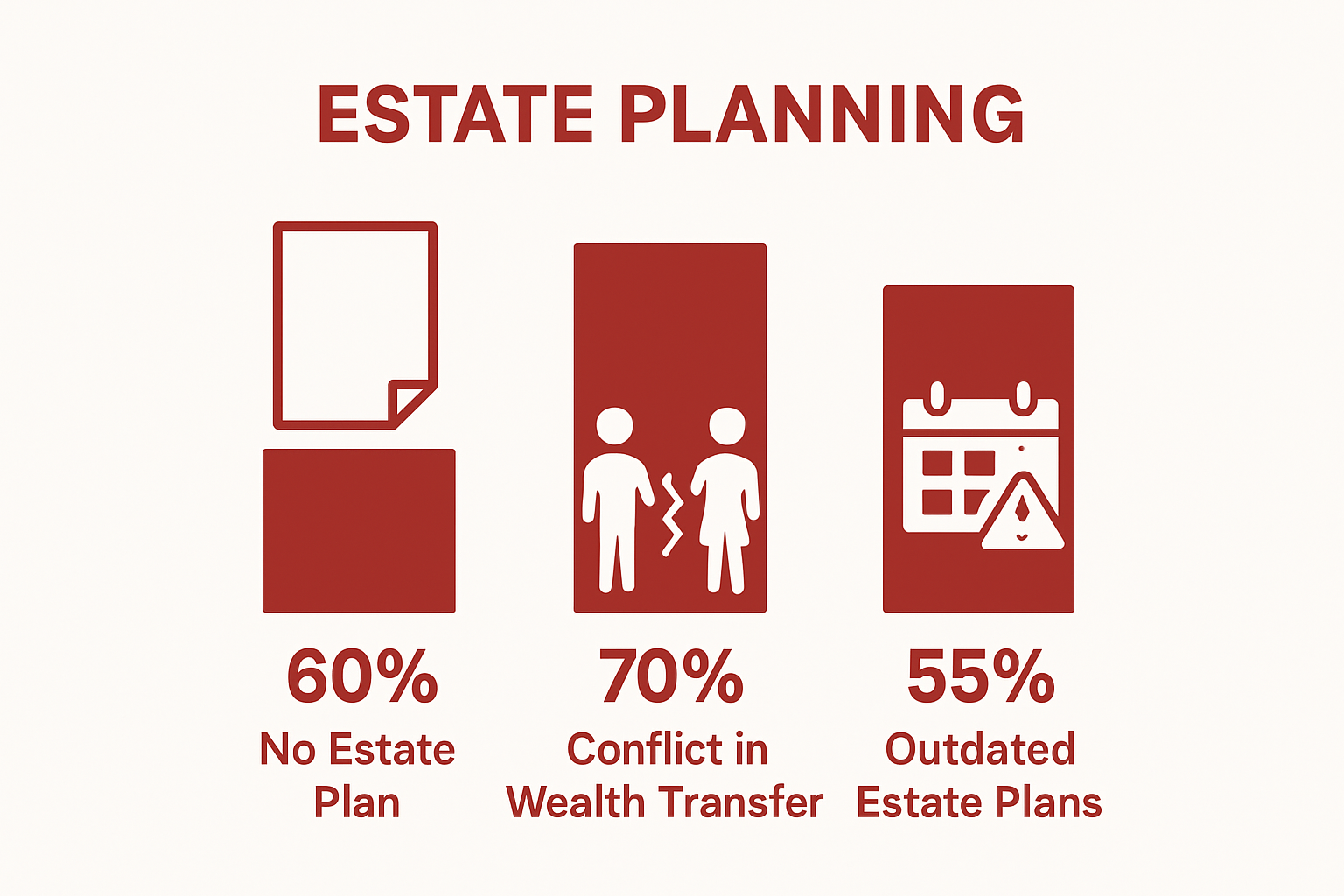
PARENTS & HOMEOWNERS: MY 7-STEP ESTATE PLANNING PROCESS WILL PROTECT YOUR HEIRS
From Creditors, Predators & Bad Choices, And Will Help You Become a (Bigger) Hero to Your Family!



Understanding Avoiding Family Conflicts Estate Planning
Estate planning sounds like something only the ultra-wealthy need to worry about. But that’s not even close. Over 60 percent of Americans have no basic will or estate plan at all, putting their families at the mercy of strangers and state decisions. The real surprise is how estate planning actually brings families together and protects every last wish, no matter how complicated life gets.
Table of Contents
- What Is Estate Planning And Why It’s Important
- The Impact Of Family Dynamics On Estate Distribution
- Key Legal Tools To Prevent Conflicts
- Strategies For Educating Heirs About Wealth
- Maintaining Flexibility In Estate Plans Over Time
Quick Summary
| Takeaway | Explanation |
|---|---|
| Establish an estate plan early | Create a plan to safeguard and distribute your assets according to your wishes before legal issues arise. |
| Communicate openly with family | Transparency helps prevent conflicts over inheritances and clarifies expectations among heirs. |
| Utilize legal tools effectively | Implement trusts and other instruments to minimize disputes and protect family dynamics during estate distribution. |
| Educate heirs about finances | Provide financial education to future generations to promote responsible asset management and preserve wealth. |
| Regularly update your estate plan | Review and revise your estate plan periodically to adapt to changes in life circumstances and laws. |
What is Estate Planning and Why It’s Important
Estate planning is a strategic legal process that allows individuals to organize and manage their assets during life and after death, ensuring their financial legacy is protected and distributed according to their precise wishes. Our comprehensive guide on estate planning provides deeper insights into this critical financial protection strategy.
Understanding the Core Purpose
At its fundamental level, estate planning transcends simple wealth transfer. It represents a comprehensive approach to protecting your family’s financial future by making intentional decisions about asset distribution, minimizing potential tax burdens, and preventing potential conflicts among heirs. The primary goal is creating a clear roadmap for your assets that reflects your personal values and family dynamics.
Estate planning involves more than just drafting a will. It encompasses several critical components that work together to provide holistic financial protection:
- Designating legal guardians for minor children
- Establishing trusts to control asset distribution
- Minimizing potential estate and inheritance taxes
- Providing clear instructions for medical and financial decisions if you become incapacitated
- Protecting family businesses and significant personal assets
Why Estate Planning Matters
According to research from the American Bar Association, over 60% of Americans do not have a basic will or estate plan. This staggering statistic reveals a significant vulnerability that can leave families financially exposed and vulnerable to legal complications.
Without a properly structured estate plan, state laws will determine how your assets are distributed, which may dramatically conflict with your personal wishes.
 This means strangers essentially decide your family’s financial future instead of you making those critical decisions. By proactively creating a comprehensive estate plan, you maintain control, protect your loved ones, and provide clear guidance during emotionally challenging times.
This means strangers essentially decide your family’s financial future instead of you making those critical decisions. By proactively creating a comprehensive estate plan, you maintain control, protect your loved ones, and provide clear guidance during emotionally challenging times.
The Impact of Family Dynamics on Estate Distribution
Family dynamics play a critical role in estate planning, often creating complex emotional and legal challenges that can significantly impact asset distribution and long-term family relationships. Navigating estate planning for blended families requires careful consideration of unique familial contexts.
Understanding Potential Conflict Sources
Family dynamics introduce numerous potential sources of conflict during estate distribution. Unresolved emotional tensions, historical family disagreements, and perceived inequities can transform an inheritance process into a divisive legal battle. These conflicts frequently emerge from situations such as:
This table provides a concise overview of the most common sources of family conflict in estate distribution, helping you understand the drivers behind inheritance disputes.
| Source of Conflict | Description |
|---|---|
| Remarriage and Stepfamily Issues | Complications arising when families blend after remarriage |
| Unequal Financial Support | Perceived or real differences in support given to children |
| Individual Relationships | Varying personal connections between heirs and parents |
| Inheritance Expectations | Differing beliefs about what each family member should receive |
| Business Ownership Transfer | Conflicts surrounding division or continuity of family businesses |
- Remarriage and stepfamily complications
- Unequal financial support provided to different children
- Variations in individual relationships with parents
- Differing expectations about inheritance amounts
- Business ownership transfer complexities
According to research from the National Endowment for Financial Education, approximately 70% of intergenerational wealth transfers experience significant family conflicts, highlighting the profound importance of proactive planning.
Strategies for Mitigating Family Conflict
Transparent communication emerges as the most powerful tool in preventing estate distribution disputes. This involves creating clear, documented expectations that address potential sources of tension before they escalate. Effective strategies include:
- Holding family discussions about estate plans
- Creating detailed documentation explaining inheritance decisions
- Establishing fair and consistent distribution principles
- Considering individual family member needs
- Working with professional estate planning attorneys to mediate potential conflicts
By acknowledging and addressing potential emotional and financial dynamics proactively, families can transform estate planning from a potential source of conflict into an opportunity for understanding and mutual respect.
Key Legal Tools to Prevent Conflicts
Preventing family conflicts during estate distribution requires strategic legal planning and precise documentation. Our comprehensive asset protection strategies provide critical insights into protecting your family’s financial future.
Understanding Legal Protective Instruments
Legal tools serve as critical mechanisms for minimizing potential estate distribution disputes. These instruments provide clear, legally binding guidance that can significantly reduce ambiguity and potential family disagreements. Comprehensive estate planning involves utilizing multiple strategic legal documents that work together to protect your assets and family’s interests.
To help you compare the main legal documents used in estate planning, this table summarizes key protective instruments discussed in the article.
| Legal Instrument | Purpose | Conflict Prevention Benefits |
|---|---|---|
| Revocable Living Trust | Manages and distributes assets during and after life | Avoids probate, allows customization, privacy |
| Irrevocable Trust | Removes assets from the estate and limits control | Protects from creditors, reduces disputes over ownership |
| Advanced Healthcare Directive | Specifies medical wishes if incapacitated | Prevents family disagreements about medical care |
| Durable Power of Attorney | Authorizes someone to manage finances if incapacitated | Ensures smooth financial management, prevents power struggles |
| Beneficiary Designations | Directs specific assets to named heirs | Reduces confusion, provides clear inheritance lines |
Key protective legal instruments include:
- Revocable living trusts
- Irrevocable trusts
- Advanced healthcare directives
- Durable powers of attorney
- Comprehensive beneficiary designations
Specialized Legal Mechanisms for Conflict Prevention
Research from legal documentation analysis demonstrates that precise legal documentation can dramatically reduce potential inheritance conflicts. Trusts emerge as particularly powerful tools in managing complex family dynamics and asset distribution.
Specific trust mechanisms that help prevent conflicts include:
- Spendthrift trusts that protect assets from beneficiary mismanagement
- Generation-skipping trusts for multi-generational wealth transfer
- Incentive trusts that encourage specific behaviors or achievements
- Discretionary trusts that provide flexible distribution guidelines
- Special needs trusts for family members with unique requirements
By implementing these sophisticated legal tools, families can create clear, enforceable frameworks that minimize potential disputes and ensure their precise wishes are honored.

Strategies for Educating Heirs About Wealth
Successful wealth transfer extends far beyond financial documentation, requiring deliberate and thoughtful education of future generations about responsible asset management. Learn how to have difficult conversations about estate planning to help prepare your family for meaningful wealth transition.
Understanding Generational Financial Education
Comprehensive heir education represents a critical component of sustainable wealth preservation. This process involves more than simply teaching financial mechanics; it requires developing a holistic understanding of family values, financial responsibility, and long-term wealth management strategies.
Key elements of effective wealth education include:
- Developing financial literacy from an early age
- Creating transparent communication about family assets
- Teaching investment and budgeting principles
- Discussing family financial history and values
- Encouraging entrepreneurial and independent thinking
Building a Comprehensive Financial Knowledge Framework
Research from the Williams Group Wealth Consultancy reveals that 70% of intergenerational wealth transfers fail due to lack of preparation and communication. Successful wealth education transforms inheritance from a potential burden into an empowering opportunity for personal and financial growth.
Strategic approaches to heir education involve:
- Gradual introduction of financial concepts
- Mentorship and hands-on learning experiences
- Creating supervised investment opportunities
- Developing emotional intelligence alongside financial skills
- Establishing family governance structures
By investing time in comprehensive heir education, families can create a sustainable legacy that extends well beyond monetary assets, fostering financial wisdom, mutual understanding, and long-term family cohesion.
Maintaining Flexibility in Estate Plans Over Time
Estate planning is not a one-time event but an ongoing process that requires consistent review and adaptation. Learn why regularly updating your estate plan is crucial to ensure your financial legacy remains aligned with your evolving life circumstances.
Understanding Dynamic Estate Planning
Flexibility represents the cornerstone of effective long-term estate planning. Life is inherently unpredictable, with significant personal, financial, and legal changes occurring that can dramatically impact your original estate strategy. Successful estate plans must be designed with built-in mechanisms that allow for seamless adjustments without compromising the fundamental intent of your wealth distribution.
Key factors necessitating estate plan flexibility include:
- Significant changes in family structure
- Substantial shifts in financial net worth
- Evolving tax legislation
- Changes in personal health conditions
- Significant alterations in business ownership
Strategic Adaptation Mechanisms
Research from the American College of Trust and Estate Counsel indicates that approximately 55% of estate plans become outdated within five years of creation. Implementing adaptive strategies ensures your estate plan remains relevant and effective throughout different life stages.
Critical strategies for maintaining estate plan flexibility involve:
- Utilizing revocable living trusts
- Establishing periodic review schedules
- Creating contingency clauses
- Maintaining open communication with potential beneficiaries
- Working with experienced estate planning professionals
By proactively designing estate plans with inherent adaptability, families can protect their financial legacy while remaining responsive to life’s inevitable changes.
Secure Your Family’s Future and Prevent Costly Disputes
Worried about misunderstandings or arguments tearing your family apart over inheritance? You are not alone. This article explained how unresolved family dynamics and unclear estate plans often lead to stress, delays in probate, and even legal battles. At the Law Office of Eric Ridley | Estate Planning | Wills & Trusts, we know that protecting your legacy means preparing today to avoid tomorrow’s conflicts.

Start building true peace of mind for your family. Let us help you draft clear wills, trusts, and other essential estate documents tailored to your unique situation. Take the first step now by visiting Law Offices of Eric Ridley and see how thoughtful estate planning solutions can protect your loved ones from uncertainty, unnecessary costs, and family strife. Book your confidential consultation today.
Frequently Asked Questions
What is estate planning and how can it prevent family conflicts?
Estate planning is the process of organizing and managing your assets during life and after death. It prevents family conflicts by clearly outlining asset distribution, setting expectations, and minimizing the potential for disputes among heirs.
How can family dynamics influence the estate planning process?
Family dynamics can create emotional tensions and potential conflicts when distributing assets. Factors such as remarriage, unequal financial support, and differing expectations among family members can lead to disputes, making proactive communication essential in estate planning.
What legal tools can help mitigate conflicts related to estate distribution?
Legal tools such as revocable living trusts, advanced healthcare directives, and durable powers of attorney can help mitigate conflicts. These instruments provide clear, legally binding guidance, reducing ambiguity in the distribution of assets.
How important is communication with heirs during the estate planning process?
Communication with heirs is vital in the estate planning process as it fosters transparency and helps set clear expectations. Discussing plans openly can prevent misunderstandings and disputes, ultimately leading to a more cohesive family dynamic during the inheritance process.
Recommended
- Avoiding Probate Disputes in California: Protect Your Wealth in 2025 – Law Office of Eric Ridley
- How to Have Difficult Conversations About Estate Planning with Family – Law Office of Eric Ridley
- How to Avoid Probate with Proper Estate Planning – Law Office of Eric Ridley
- Family Meetings About Estate Planning: Protecting Your Legacy in California (2025) – Law Office of Eric Ridley
- Understanding Family Conflict Resolution Strategies – Mastering Conflict
